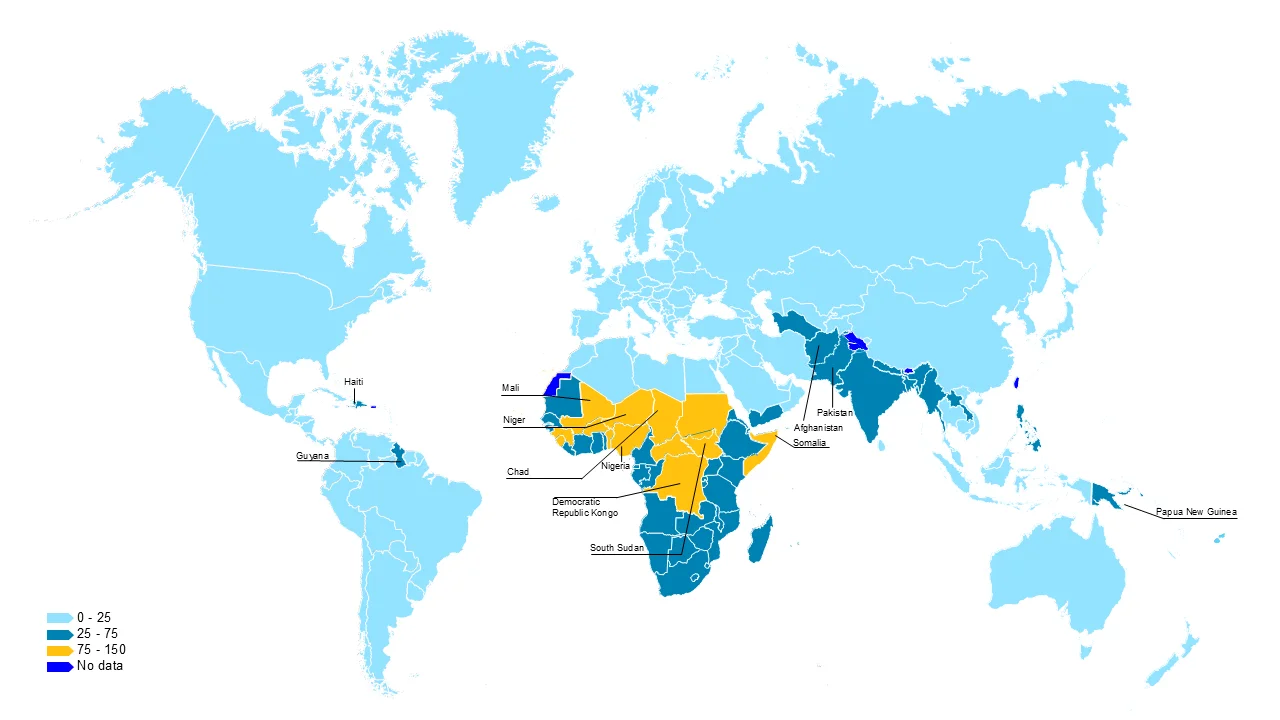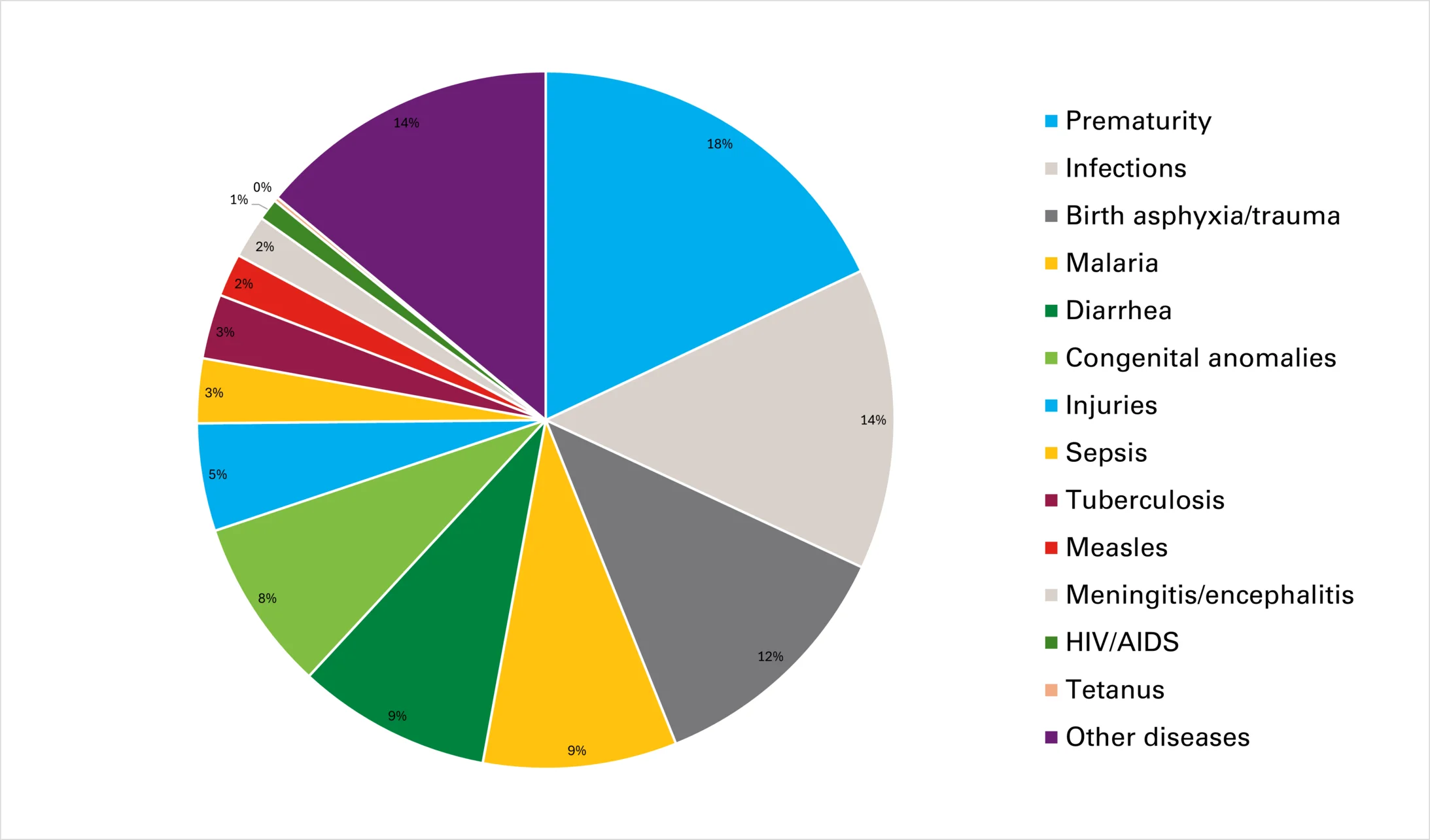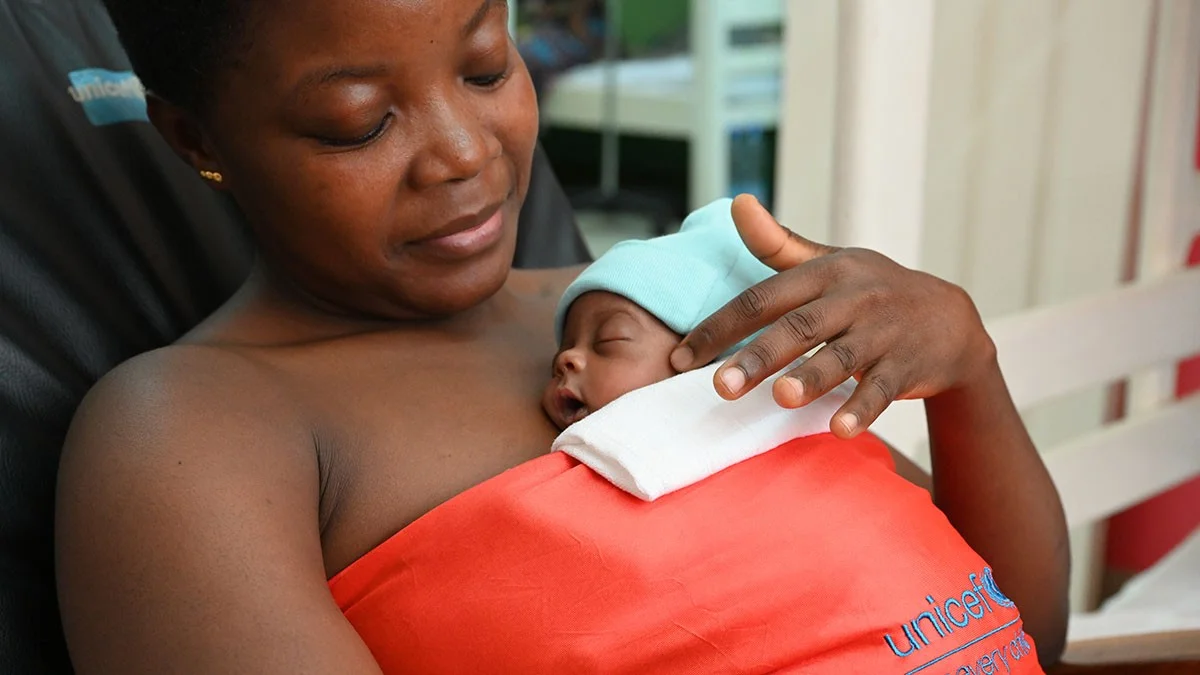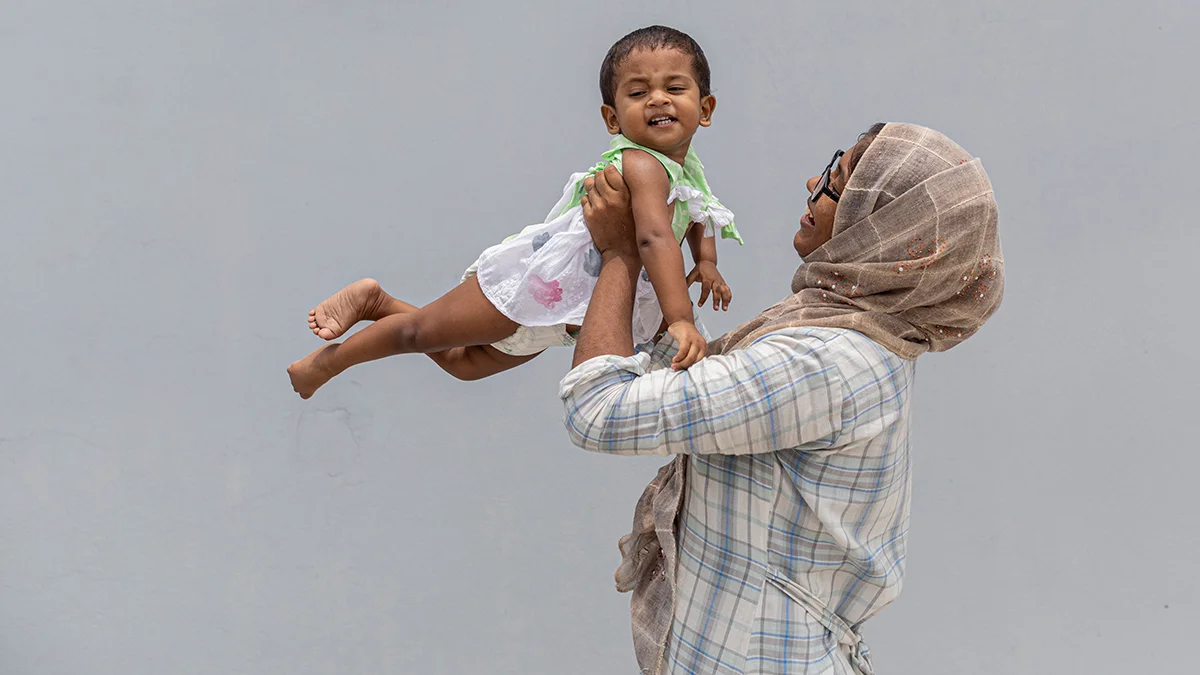A global problem that affects us all
In a world dominated by negative headlines, there are also hopeful developments that we should not forget: According to the latest UNIGME estimates, global under-five deaths have dropped below five million for the first time – a historic low. However, the estimated figures are still high. In 2022, around 4.9 million children died before reaching age five. And in most cases, these tragic deaths were avoidable.
Globally, child mortality has declined by 51 percent since 1990. Several low- and middle-income countries have even outpaced this decline. However, the reality remains sobering: In 2022, children under five died at a rate of one every six seconds. This is not about statistics. It is about children. The findings show that despite the progress that has been made, we are still far from ending all preventable deaths for children under five.
Global child mortality figures are still high and signify a global societal crisis and deep-rooted inequalities and structural problems like poverty, inadequate healthcare, malnutrition and social inequality – problems that are often overlooked.
Improving child survival remains a matter of urgent concern and requires our attention and comprehensive measures.
Child mortality, also known as under-five mortality, refers to the number of children who die before their fifth birthday. The child mortality rate refers to how many children under the age of five, per 1,000 live births, die during a certain period of time.
Child (or under-five) mortality rate
The probability of a newborn dying before reaching exactly 5 years of age (expressed per 1,000 live births)
Infant mortality rate
The probability of a newborn dying before reaching exactly 1 year of age (expressed per 1,000 live births)
Neonatal mortality rate
The probability of a newborn dying within the first 28 days of life (expressed per 1,000 live births)
- Annually = 4.9 million (uncertainty margin of 4.6 to 5.4 million)
- Per month = 408,000
- Per day = 13,000
Every six seconds, a child under the age of five dies.
278 million children died before age five between 1990 and 2022
Which countries have the highest child mortality?
The Sub-Saharan African countries with the highest mortality rates are Niger, Nigeria, Somalia, Chad and Sierra Leone. Niger has the world’s highest mortality rate (177.34 per 1,000 live births), according to estimates from 2022. In South Asia the highest mortality rates are in Pakistan and Afghanistan.
What are the leading causes of death?
The main causes of global child mortality are from diseases related to neonatal mortality (in the first 28 days) and infections (such as pneumonia). This requires urgent change. It is clear that greater attention must be paid to this critical early period of a newborn’s life to prevent avoidable deaths. Children with severe acute malnutrition are especially at risk of dying from common childhood illnesses – weakened from malnutrition, their bodies cannot fight off diseases.
Unequal chances
It is shocking but true. Around the world, children do not have the same chances of survival. Child mortality is greatest in Sub-Saharan Africa (57 percent) and South Asia (26 percent), where four out of five children die before the age of five. In these two regions, only three out of five births are live births. Survival is also linked to wealth, with twice as many children from poor families dying before the age of five as do children from rich families.
Cautious optimism and concerted efforts
Despite the good news about global child mortality falling by half since 1990, there are still currently 59 countries that will not meet the Sustainable Development Goal of reducing the under-five mortality rate to below 25 per 1,000 live births. Using the latest figures, we can predict that by 2030, 35 million children will die before reaching the age of five.
The findings are clear:
Rising inequality and economic instability and many new and long-standing conflicts are presenting significant challenges. In many parts of the world, the escalating effects of climate change and the long-term impacts of COVID-19 are putting children’s lives in jeopardy.
Country examples
Niger:
Current situation:
- Less than half of all children and mothers have access to healthcare facilities.
- Many challenges within the healthcare system and a shortage of health workers.
- Climate change (heat, flooding, food insecurity) has exacerbated existing problems.
- Only 20 percent of small children sleep under mosquito nets, heightening the risk of malaria.
Trend and forecast:
- The child mortality rate in Niger has fallen from 332 in 1990. It is expected to fall to 36 by 2050.
Pakistan:
Current situation:
- No access to safe drinking water in areas affected by flooding.
- Children are more susceptible to malnutrition and disease.
- Outfitting more health facilities with resilient energy systems to prevent up to 175,000 deaths by 2030.
- An improved energy supply that can recover more quickly from shocks and disruptions means a lower disease burden.
Trend and forecast:
- The child mortality rate in Pakistan has fallen from 139 in 1990. It is expected to fall to 35 by 2050.
Haiti:
Current situation:
- Implementation of measures to reduce malnutrition.
- Significant differences in healthcare in urban vs rural areas.
- Very little access to basic health services in rural areas.
- Most unvaccinated children live in poor urban neighborhoods.
- Shortage of health workers.
Trend and forecast:
- The child mortality rate in Haiti has fallen from 144 in 1990. It is expected to fall to 30 by 2050.
Looking away is not an option
The problem of child mortality presents a key lesson for the global community. Often, the national healthcare systems do not have the means to reduce child mortality effectively. Child mortality may not be many governments’ highest priority, but the high child mortality rates in many countries show that it is an ongoing problem. We must therefore do everything we can to strengthen weak and underfunded healthcare systems worldwide so that they can do what is needed to lower child mortality sustainably. And this is where UNICEF comes in. UNICEF is committed to ensuring that every child in the world can grow up safe and healthy.
With the Sustainable Development Goals, the global community has set ambitious goals to allow us to live together peacefully in a just world in the future. That includes the expectation that no child should die from preventable causes. Every child has the right to survive. This is an important issue in the Convention on the Rights of the Child and the Agenda 2030 for Sustainable Development.
We already have the knowledge and the means to prevent many of these deaths. If we fail to utilize this knowledge, are we not tacitly accepting this high child mortality rate? This is a difficult question, and requires us to reflect on our responsibility as a global society. It reminds us that we should not resign ourselves to the status quo, but actively take on the challenges in front of us.
A country’s high mortality rate is often a symptom of deep-rooted systemic problems like poverty, social inequality, lack of access to education and inadequate healthcare. These are not isolated problems – rather, they are tied to global challenges that threaten peace, security and economic stability. Countries with high child mortality rates often find themselves in a vicious cycle of poverty and limited opportunities for development. This not only impacts the welfare of the population – it can also endanger the stability of entire regions. By sharing resources and knowledge, the global community can work together to overcome these challenges and help create a healthier, more stable and more just world.
How can we help?
Many under-five deaths can be prevented through simple measures before, during and after childbirth. UNICEF is working to improve healthcare in the world’s poorest countries. Better hygiene, vaccinations and effective medicines against diseases like malaria also help to lower child mortality.
UNICEF is involved in outfitting local health facilities with lifesaving medicines and medical equipment, training health workers and conducting large-scale vaccination campaigns for diseases such as malaria.
One thing is certain. We cannot change the past. But we can learn from it. We still have a long way to go to end preventable child deaths, but with continued commitment and greater investment we will achieve this goal.
Outlook – a renewed promise
Reducing child mortality requires investment in antenatal and postnatal care by qualified health workers and investment in basic neonatal care, including care for small and sick newborns. The numbers show that we can reach long-term goals to ensure the health and survival of children when we work sustainably.
As part of the global community, we can work at different levels to lower child mortality rates permanently. We must ensure that people in the world’s poorest regions also have access to basic healthcare and immunizations. Access to safe water and proper sanitary facilities is also needed to prevent the spread of disease. Education for mothers and families also plays a key role in raising awareness of healthy habits and preventive measures. Through targeted financial support and the use of modern technology, we can develop innovative solutions to help people in even the remotest areas.
Our aim is to show global solidarity, investing together in a future in which all children have the chance to live a healthy life.
By working together, we can achieve this goal – for every child, all around the world.
8 things you should know about child mortality
Under-five mortality rate has declined by half since 2000
2.3 million newborns and 2.6 million children under five died in 2022
High child mortality in regions affected by poverty and armed conflict
Many countries will not meet the goals for reducing child mortality without intervention
Some countries have been able to reduce their child mortality rates in spite of limited resources
There is a critical need for investment in vaccinations and obstetric care
Many countries lack current data on child mortality, making intervention more difficult
Local measures and greater investment in the health of mothers and children are needed








